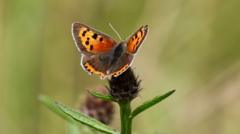Is the UK Experiencing an Insect Boom After Record-Breaking Spring?

Understanding the Impact of Climate on Insect Populations in the UK
The UK has recently experienced its warmest and sunniest spring on record, leading to a noticeable boom in certain insect populations, such as ladybirds, butterflies, and wasps. This surge can largely be attributed to favorable weather conditions that have allowed for a robust growth of aphids, which serve as a primary food source for many beneficial insects. However, as we delve deeper into the effects of climate change and the variability of weather patterns, the outlook for insect populations may not be as bright in the long term. This article will explore the current trends in insect populations, the factors influencing these trends, and what we can do to support biodiversity in our ecosystems.
The Current Insect Population Boom
In 2025, the UK has witnessed a remarkable increase in the populations of several flying insects. According to the Royal Horticultural Society (RHS), the warm and dry conditions have led to a significant rise in aphid numbers, which in turn has supported a healthy population of ladybirds. Kathryn Brown, the director of climate change and evidence at The Wildlife Trusts, notes that many people have observed an uptick in ladybirds, wasps, and other insects this year, especially following a disappointing 2024 for species like butterflies.
Insects thrive in warm, sunny conditions. The RHS had accurately predicted an abundant year for aphids, which has become a double-edged sword for gardeners. While the increase in aphid numbers can be a nuisance, they play a crucial role in the food chain, serving as a food source for birds and other insects. Dr. Hayley Jones, a principal entomologist at the RHS, suggests that as ladybird populations grow, they will begin to naturally control aphid numbers, leading to a cyclical balance in the ecosystem.
The Butterfly Effect: A Barometer of Ecosystem Health
Butterflies are often viewed as indicators of environmental health, and their populations have been observed in decline since the 1970s. However, 2025 has been an extraordinary year for butterflies, with 18 species spotted at least two weeks earlier than usual, and 24 species observed at least a week early. This resurgence is a stark contrast to last year's "butterfly emergency," when the lowest number of butterflies on record was reported due to unfavorable weather conditions.
Butterflies, being ectothermic (cold-blooded), rely heavily on warmth and sunlight to regulate their body temperature and energy levels for flight. This year's warmer temperatures have facilitated quicker life cycles for these insects, leading to higher survival rates. As they spend less time in vulnerable caterpillar stages, the chances of predation decrease, allowing for more butterflies to reach maturity. Lepidopterist Martin Wills, who tracks butterfly populations at Hutchinson's Bank Nature Reserve in south London, confirms that this year's butterfly season has been exceptional, with record early sightings.
Lavender Fields and Pollinators: A Beautiful Relationship
Adjacent to Hutchinson's Bank Nature Reserve are some of the UK’s stunning lavender fields, which thrive in sunny, warm conditions. This year, lavender has bloomed much earlier than usual, attracting a plethora of bees and butterflies. Lorna May, the owner of Mayfield Lavender in Surrey, reported a tenfold increase in honey production compared to last year, attributing this success to the flourishing bee population. However, the increase in pests, such as the shiny rosemary beetle, poses new challenges for growers.
To mitigate pest issues without resorting to pesticides, a dedicated group of volunteers has been hand-picking these bugs. Nevertheless, an early bloom of lavender raises concerns about the plant's longevity, as it may die off sooner than expected, potentially disrupting local biodiversity throughout the summer months. Kathryn Brown emphasizes that climate change is contributing to unpredictable patterns in nature, leading to greater "boom and bust" cycles for wildlife.
The Long-Term Outlook: Challenges and Concerns
Despite the short-term increase in insect populations, the long-term outlook remains concerning. The latest State of the UK Climate report, published by the Met Office, indicates that weather extremes have become the new norm, with hotter, drier summers occurring more frequently. Eight out of the ten warmest springs in the UK have been recorded since 2000, with the top three occurring since 2017.
Insects are particularly vulnerable not only to extreme weather conditions but also to habitat loss and the widespread use of pesticides. These factors can critically undermine the delicate balance necessary for healthy ecosystems. Insects play vital roles in pollination, serve as essential food sources, and contribute to decomposition processes, making their decline particularly alarming.
How Can We Support Insect Populations?
To help combat the decline of insect populations, individuals can take several proactive steps. Here are some practical actions you can consider:
- Mow Less Often: Allowing your lawn to grow longer can provide habitat and food for various insect species.
- Support Local Rewilding Projects: Participate in or donate to initiatives aimed at restoring natural habitats.
- Create Ponds: Establishing small ponds can offer essential water sources for various wildlife, including insects and amphibians.
These simple actions can significantly contribute to the health and sustainability of local ecosystems.
Frequently Asked Questions
Why are insect populations important for ecosystems?
Insects play critical roles in ecosystems, including pollination of plants, serving as a food source for other animals, and aiding in decomposition processes. Their decline can significantly impact biodiversity and ecosystem health.
What factors are contributing to the decline of flying insects in the UK?
Factors such as habitat loss, pesticide use, climate change, and extreme weather conditions are all contributing to the decline of flying insects in the UK.
How can I create a more insect-friendly garden?
Creating an insect-friendly garden can be achieved by reducing pesticide use, planting native flowers, providing water sources, and allowing areas of your garden to grow wild.
Conclusion
This year has shown a remarkable increase in certain insect populations in the UK, largely due to favorable weather conditions. However, the long-term outlook remains precarious, with climate change and habitat loss posing significant challenges. By taking steps to create more sustainable environments, we can all contribute to the health of our ecosystems. How will you take action to support biodiversity in your local area?
#InsectConservation #Biodiversity #ClimateChange
Published: 2025-07-26 06:35:15 | Category: technology



